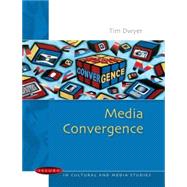
| Series Editor's Foreword | p. xiii |
| Acknowledgements | p. xv |
| Introduction | p. 1 |
| Studying media convergence | p. 5 |
| Mediatizing convergence and cultural change | p. 6 |
| Industrial convergence | p. 9 |
| Technological convergence | p. 12 |
| Regulatory convergence | p. 14 |
| Industry consolidation, media convergence, democracy | p. 16 |
| Web 2.0 and network convergence | p. 17 |
| The Internet, advertising and search businesses | p. 18 |
| Conclusion | p. 20 |
| Further reading | p. 22 |
| Interpreting Media Convergence | p. 24 |
| Introduction | p. 24 |
| Production, distribution, consumption | p. 26 |
| Convergence and market freedom | p. 27 |
| Co-evolution of old and new media | p. 30 |
| Internetization and mediatization | p. 32 |
| Video and the new 'distribute-it-yourself' ethos | p. 34 |
| After 'Web 2.0' | p. 37 |
| The network society and network intensification/extensification | p. 40 |
| Mobilities | p. 42 |
| Conclusion | p. 45 |
| Further reading | p. 46 |
| Traditional Media Moves Online | p. 47 |
| Introduction | p. 47 |
| Next year's model | p. 48 |
| Shifting advertising practices | p. 52 |
| Acquiring online assets | p. 54 |
| New media deals and 'taking it private' | p. 60 |
| Online news and diversity | p. 65 |
| Conclusion | p. 67 |
| Further reading | p. 68 |
| Media Ownership and the Nation-State | p. 69 |
| Introduction | p. 69 |
| Rationales of pluralism and diversity | p. 70 |
| Public interest discourses and citizenship | p. 73 |
| International developments | p. 79 |
| Nation-states compared | p. 111 |
| Conclusion | p. 115 |
| Further reading | p. 116 |
| Audiences of Neoliberal Imaginaries | p. 118 |
| Introduction | p. 118 |
| Networked individualism | p. 120 |
| Propaganda revisited | p. 125 |
| Multichannelism, 'the long tail', interactivity | p. 128 |
| Voices in neoliberal media markets | p. 129 |
| User content and 'audiencing' | p. 131 |
| Conclusion | p. 132 |
| Further reading | p. 133 |
| Living at the Network Edge | p. 134 |
| Introduction | p. 134 |
| Accounting for broadband | p. 137 |
| Rethinking USOs for broadband networks | p. 138 |
| Broadband convergence | p. 147 |
| Net neutrality | p. 151 |
| Digital delays | p. 153 |
| Conclusion | p. 156 |
| Further reading | p. 156 |
| Conclusion | p. 158 |
| Information infrastructures, diversity, scale | p. 161 |
| New welfarist models of media communications policy | p. 165 |
| Informationalism and democracy | p. 167 |
| The view from here | p. 169 |
| Further reading | p. 171 |
| Glossary of Key Terms | p. 172 |
| References | p. 178 |
| Index | p. 193 |
| Table of Contents provided by Ingram. All Rights Reserved. |
The New copy of this book will include any supplemental materials advertised. Please check the title of the book to determine if it should include any access cards, study guides, lab manuals, CDs, etc.
The Used, Rental and eBook copies of this book are not guaranteed to include any supplemental materials. Typically, only the book itself is included. This is true even if the title states it includes any access cards, study guides, lab manuals, CDs, etc.